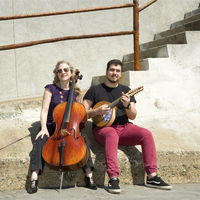An evening of Brazilian music with a dazzling city backdrop
Downtown, Boston
Fri, November 15, 2024, at 7:00 PM,
EST

- Bring your own drinks
- Alcoholic and non-alcoholic drinks provided
-

- All guests must be 21
-

- Dogs live here
-
Wheelchair access
- Wheelchair Accessible
This is a groupmuse
A live concert in a living room, backyard, or another intimate space. They're casual and friendly, hosted by community members.
Host

Join us for a magical night of Brazilian music! Brazilian mandolinist Ian Coury and multi-style cellist Catherine Bent will dazzle us with music influenced by choro, samba, and forró in front of a stunning backdrop of the city skyline from a high-rise apartment in downtown Boston. Doors open at 7:00 PM, music starts at 7:30 PM. Come join us to unwind with a glass of vinho, meet new people, and listen to some amazing music!
What's the music?
Local multi-style cellist Catherine Bent and Brazilian mandolin prodigy Ian Coury dazzle and charm listeners with their unique take on Brazilian instrumental music.
Catherine Bent, an alumna of Cirque du Soleil, has performed and recorded with Joe Jackson, Lee Konitz, Donna Summer, and many others. She is regarded in Brazil as the leading cellist in the choro genre. Ian Coury is an award-winning 10-string bandolim player and composer from Brazil who has shared stages with Brazilian legends like Toninho Horta and Hamilton de Holanda.
The two have a musical connection that transcends their backgrounds and crystallizes around their passion for Brazilian choro music. Choro (pronounced “shoh-roh") is an instrumental music that has its origins in late 1800s Rio de Janeiro. It's been likened to New Orleans jazz, and shares that tradition's improvisation, soulfulness, and often irrepressible joyfulness.
Where does this music come from?
Choro music arose in 19th century Rio de Janeiro from the union of West African rhythms and dances (principally the lundu), and European popular dance (including polka, schottisch and waltz).
This occurred in the upper-class ballrooms, and also in the streets and bars of Rio and its suburbs.
In essence an oral tradition, choro lends itself as easily to intricate arrangements as to extravagant and spontaneous improvisation.
This program will feature both!
Location
Exact address sent to approved attendees via email.
This is a groupmuse
A live concert in a living room, backyard, or another intimate space. They're casual and friendly, hosted by community members.
Host

Attendees


















 Continue with Facebook
Continue with Facebook
 Continue with Google
Continue with Google
 Continue with Apple
Continue with Apple
Comments (2)
Comment sections are only for participants.